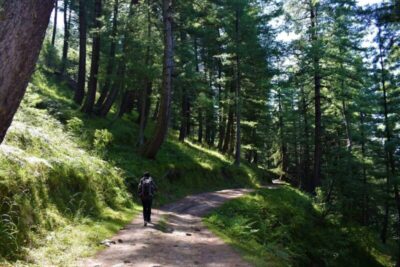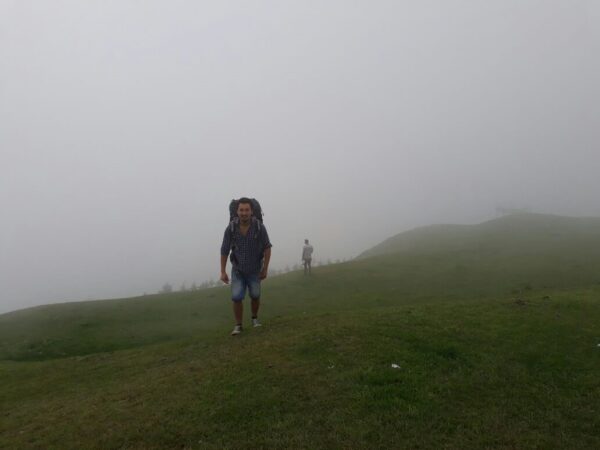Himachal
Places to visit
Bijli Mahadev Temple Complete Guide

Bijli Mahadev or the God of Lightning is one of the oldest Shiva temples and it is struck by lightning…
Sitting on a mountain top in Kullu-Manali of Himachal Pradesh, Shiva temple of Bijli Mahadev or the God of Lightning offers spectacular views of mighty Himalayas above and green lush valleys below. It’s a truly exhilarating experience to stand in front of the Bijli Mahadev temple.
Here is everything you need to know before visiting the Bijli Mahadev temple.
Bijli Mahadev temple guide
1. Why is Bijli Mahadev temple famous?

The temple is famous primarily because it’s one of the few Shiva temples situated on a mountain top and that too at around 2300 meters. There is a huge ground, one of the few ones in the entire Kullu valley, which surrounds the temple.
The temple has also been a place of pilgrimage since the old times. Thousands of devotees visit the temple during the Sawan month of July when a fair is organised here to pay respect to lord Shiva.
Another old Shiva temple of Basheshar Mahadev is also nearby in the nearby Bajaura.
2. What is the history of Bijli Mahadev temple?

According to a popular myth, Bijli Mahadev temple was built as a homage to lord Shiva, who had saved the Kullu valley from a demon named Jalandhara. The demon wanted to submerge the entire valley by stopping the flow of Beas river.
However, Lord Shiva killed him with his trident. It’s not known when the temple was built but most believe its existence to be from the ancient times.
3. Why is the temple called Bijli Mahadev?

It’s called Bijli Mahadev because of the lightning (Bijli) that strikes this place. According to locals, lightning strikes the temple, which is dedicated to Lord Shiva or Mahadev, and the wooden pole in front of it every 12 years, breaking the Shiva lingam into pieces.
The pieces are searched and the lingam is put together by the temple priest using the home-made butter (chopad) taken from the nearby villages. That’s how the temple got its name of Bijli Mahadev.
4. Where is Bijli Mahadev temple located?
The temple is located on a mountain top above Kullu and Bhuntar towns in the Western Himalayan mountains of Himachal Pradesh. It’s situated around 2300 meters above the sea level with Kullu valley on the one side and the Parvati valley on the other.
The temple is built in the Kath-Kuni architectural style with a lingam placed at its sanctum sanctorum. In front of the temple, there is a 60-foot-high wooden pole carved out of a Deodar tree and besides it are stone sculptures of Shiva lingam and Nandi bull. A rectangular wooden corridor enables the parikrama or circumambulation of the sanctum.

5. How to reach the Bijli Mahadev temple?

Till few decades back, you needed to trek all the way up to the Bijli Mahadev temple. But building of new roads have made it a lot easier to reach the temple these days. There are three routes to reach the Bijli Mahadev — from Kullu side, from Kasol or Parvati valley side and from Naggar village.
If you are in Manali, then you first need to reach Kullu and then Ramshila village, which is on the left bank of Kullu town and is also the starting point of a link road that takes you almost up to the Bijli Mahadev temple. The 23-km-long link road ends at Gobha village. From Gobha village, it takes an hour’s easy trek amidst a dense Deodar forest to reach the mountain top and the Bijli Mahadev temple.
The second route is from Parvati valley side. If you are in the Parvati valley then you will have to first reach Chhrod Nalla, which is on Bhuntar-Kasol-Manikaran road. From Chhrod Nalla, a link road takes you to Bhrain village and another non-metalled link road from this village takes you almost up to the mountain top. The remaining short walking distance to the Bijli Mahadev temple can be covered in less than an hour.
The condition of both these roads is bad. There are potholes on both the roads and it becomes quite a struggle to drive here especially during rains.
The third route is from Naggar side. There is a link road that connects Naggar with the Bijli Mahadev mountain top. However, the present road condition doesn’t make it worth recommending option. This option is best for trekking.
6. Naggar-Jana-Bijli Mahadev trek
If you have time and want to explore amazing natural beauty and the rich Deodar forests then trekking from Naggar to Bijli Mahadev is your option. This beautiful, short and easy trek starts from the heritage village of Naggar and takes you to Bijli Mahadev via Jana village.
On your way, you also cross through Kais wildlife sanctuary and enjoy the best views of both Kullu and Parvati valley. You can do this wonderful trek with the Wildcone.
7. What is the best time to visit the Bijli Mahadev temple?

April to June and September to November is the best time to visit the Bijli Mahadev temple. In the spring months of March and April, the whole Kullu and Parvati valleys are in bloom as it’s the flowering season in the fruit orchards.
The nature is also at her best. In the autumn months, the valley is less crowded but the natural surroundings remain stunningly beautiful.
8. How is the weather at the Bijli Mahadev top?

It’s always a little nippy on mountain tops even in summers especially if it rains and Bijli Mahadev is no exception. In the summers, the weather is warm and nice but rains can suddenly drop the temperature. In winters, the entire mountain top gets buried in heavy snow and is not a good time to visit until and unless you are an experienced trekker or want to try out snow trekking by hiring guides.
9. What are the Open and Close timings of the Bijli Mahadev temple?

You can visit the temple from 5 am to 10 pm and those who want to stay at the temple’s sarai or guest house, can make a request till 9 pm. The gates of the temple are closed every year in mid-December due to snowfall and cold weather conditions and reopened around three months later in mid-March. In between, the temple is opened for three days during the festival of Shivratri.
10. How is the view from the Bijli Mahadev top?

Spectacular, to say the least. You get a 360-degree view of the Parvati and Kullu valleys with lofty mountains all around and meandering Parvati and Beas rivers below. You can watch the snow-covered Rohtang Pass on your left side and Deo Tibba and other mountains on the right.
And of course, the view of Bhuntar town with its airstrip and bridges over Beas river is absolutely fabulous from this height. You can also watch Kullu town down below on the other side of the mountain top.
11. Can I stay at the Bijli Mahadev top?

Yes. There are many camping sites on the grounds of Bijli Mahadev. These sites are run mostly by the locals and you can stay in any one of them and spend the night under a stunning star-lit Milky Way in summers when it’s not that cold.




